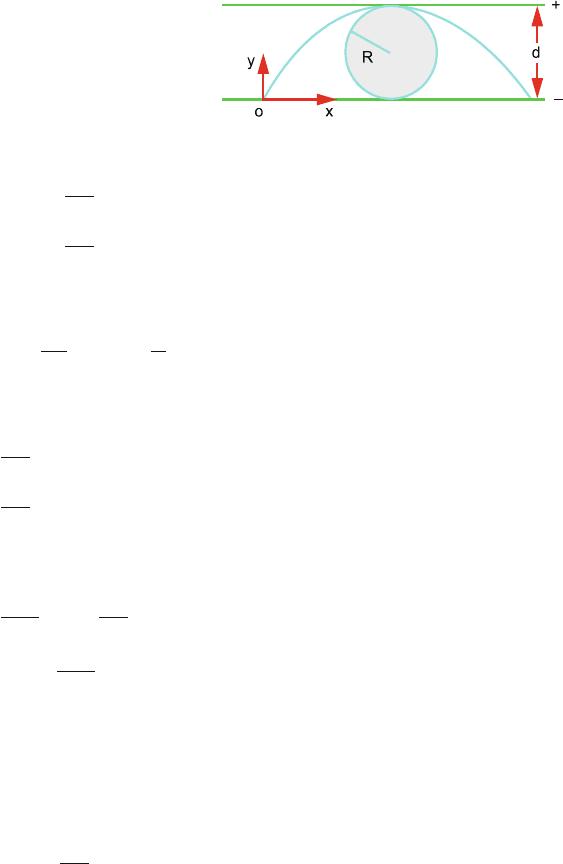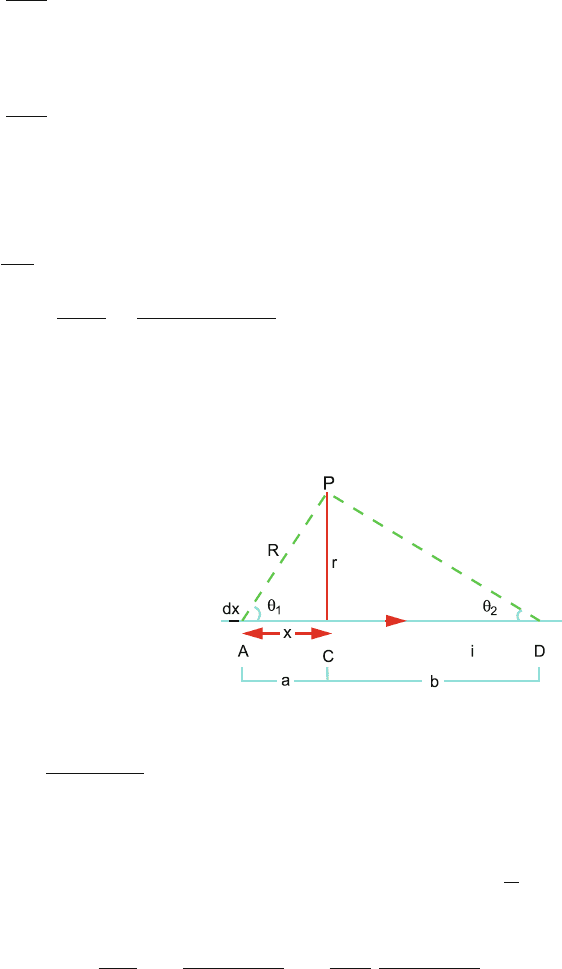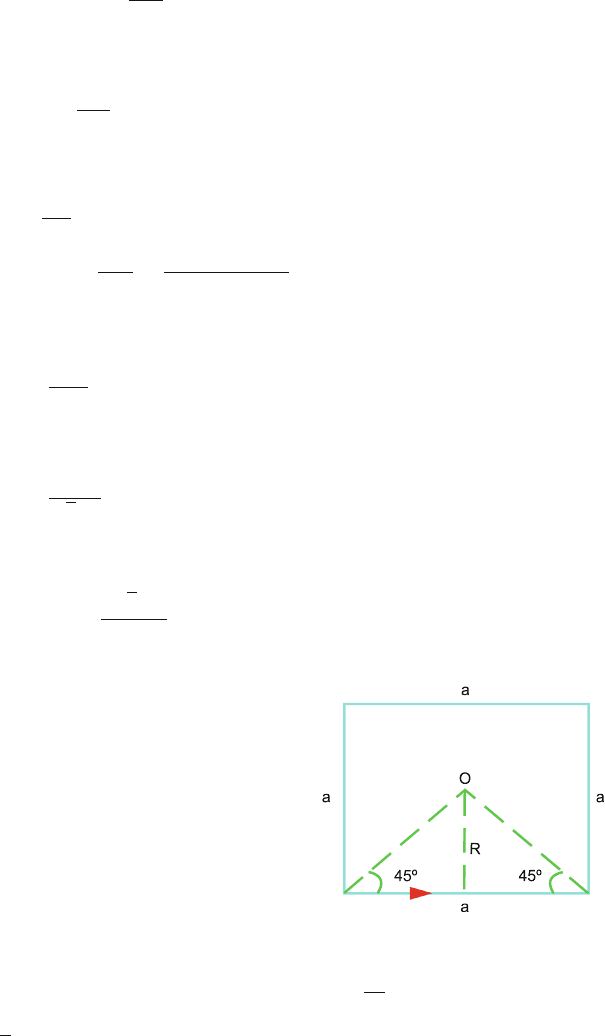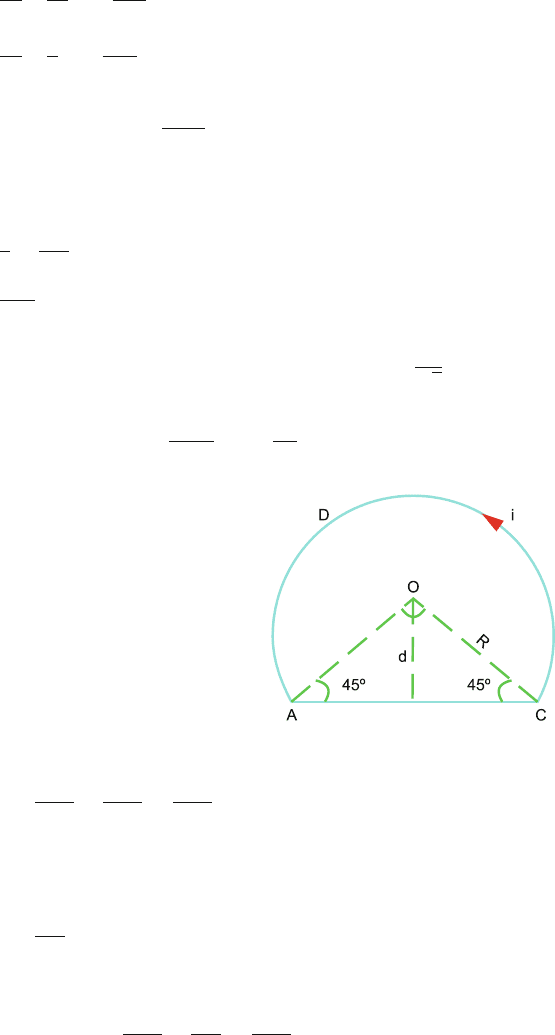Kamal A.A. 1000 Solved Problems in Classical Physics: An Exercise Book
Подождите немного. Документ загружается.


600 13 Electromagnetism I
f
p
=
Bq
2πm
p
=
1.5 × 1.6 × 10
−19
2π ×1.66 × 10
−27
= 2.3 ×10
7
Hz = 23 MHz
(b)
K
α
1
2
(2e)
2
r
2
B
2
4m
p
= K
p
= 13.56 MeV
f
α
=
(B)(2e)
2π ×4m
p
=
f
p
2
= 11.5MHz
13.3
q v B = Eq→ v =
E
B
(1)
mv
2
r
= q v B
→ r =
mv
qB
(2)
Separation = 2r
2
− 2r
1
= 2(r
2
−r
1
)
=
2 E
qBB
(m
2
− m
1
) (3)
where we have used (1) and (2).
13.4
mv
2
r
= Bev
m =
Ber
v
=
0.2 × 1.6 × 10
−19
× 0.2
2.5 × 10
7
= 2.56 ×10
−28
kg
In terms of electron mass
m =
2.56 × 10
−28
9.1 × 10
−31
= 281 m
e
Hence the particle is a pion (π – meson)
13.5
Acceleration a =
qE
m
(1)
y =
1
2
at
2
(2)
x = vt (3)
Combining (1), (2) and (3)
y =
qEx
2
2mv
2
(4)
which is the equation to a parabola.
13.6
r =
√
2mK
qB
=
(2 × 9.1 × 10
−31
× 5 × 10
3
× 1.6 × 10
−19
)
1/2
1.6 × 10
−19
× 10
−2
= 0.0238 m
= 2.38 cm

13.3 Solutions 601
13.7
qE = q v B
∴ B =
E
v
=
1500
3000
= 0.5T
13.8
(a) v =
rqB
m
=
1.9 × 1.6 × 10
−19
× 3 × 10
−5
9.1 × 10
−31
= 10
7
m/s
(b) t =
2πr
v
=
2π ×1.9
10
7
= 1.19 ×10
−6
s = 1.19 μs
13.9
B =
2πmf
q
=
2π ×2.0141 × 1.66 × 10
−27
× 5 × 10
6
1.6 × 10
−19
= 0.656 Wb/m
2
K =
1
2
q
2
r
2
B
2
m
=
1
2
×
(1.6 × 10
−19
)
2
(0.762)
2
(0.325)
2
2.0141 × 1.66 × 10
−27
= 4.696 ×10
−13
J
= 2.9MeV
13.10 For deuterons
B =
2π fm
q
=
2π ×11.5 × 10
6
× 2.014 × 1.66 × 10
−27
1.6 × 10
−19
= 1.509 Wb/m
2
For protons
f =
qB
2πm
=
1.6 × 10
−19
× 1.509
2π ×1.66 × 10
−27
= 2.316 ×10
7
c/s = 23.16 Mc/s
13.11
(a) f =
Bq
2πm
=
1.5 × 1.6 × 10
−19
2π ×3.32 × 10
−27
= 11.5 ×10
6
c/s = 11.5Mc/s
(b) K =
1
2
q
2
r
2
B
2
m
=
1
2
(1.6 × 10
−19
× 0.5 × 1.5)
2
3.32 × 10
−27
= 21.69 ×10
−13
J =
13.56 MeV
13.12 i =
q
t
=
1.6 × 10
−19
1.5 × 10
−16
= 1.06 ×10
−3
A
13.13
(i) Magnetic force, F
M
= qVB
Electric force, F
E
= qE
For no deflection, F
M
= F
E
∴ qvB = qE
∴ v =
E
B
=
80 × 10
3
0.4
= 2 ×10
5
m/s
(ii)
mv
2
r
= q v B
∴
q
m
=
v
Br
=
E
B
2
r
=
80 × 10
3
(0.4)
2
(1.14 × 10
−2
)
= 4.38 ×10
7
C/kg

602 13 Electromagnetism I
13.14 (a) F = qE +qv × B
(b) In the electric field energy acquired, K = qV
∴ p =
√
2mK =
2mqV. (1)
In the magnetic field
p = qBr (2)
Combining (1) and (2)
r =
2mV
qB
2
13.15 Let the isotopes
235
U and
238
U be called 1 and 2, respectively. In the mag-
netic field the momenta are given by
p
1
= qBr
1
, p
2
= qBr
2
p
2
− p
1
= qB (r
2
−r
1
) = 1.6 × 10
−19
× 0.2 × 2 × 10
−3
(13.26)
= 6.4 ×10
−21
kg m/s. (1)
In the electric field
qV =
p
2
1
2m
1
=
p
2
2
2m
2
(2)
∴ p
2
= p
1
m
2
m
1
= p
1
3.95 × 10
−25
3.90 × 10
−25
= 1.00639 p
1
. (3)
Combining (1) and (3)
p
1
= 1.00159 ×10
−19
kg m/s. (4)
Substituting (4) into (2)
V =
(10
−19
)
2
2 × 1.6 × 10
−19
× 3.90 × 10
−25
= 8 ×10
4
V
13.16 (a) F = q v × B
If B is perpendicular to v, then the particle would move in a circle.
Centripetal force = magnetic force
mv
2
r
= qvB → r =
mv
qB

13.3 Solutions 603
(b)
ξ =−
d
dt
(Nφ) =−
d
dt
(NBA) =−NA
dB
dt
=−NA
d
dt
(B
0
cos(15t)) = 15 NAB
0
sin(15t)
13.17
(a)
E =
q
4πε
0
r
∴ q = 4πε
0
rE = 4π × 8.85 × 10
−12
× 10
−6
× 5.8 × 10
−3
= 6.447 ×10
−19
C
Number of electrons
n =
q
e
=
6.447 × 10
−19
1.6 × 10
−19
= 4.029 or 4
(b) Minimum electric field E required to prevent the droplet from falling is
conditioned by equating the electric force to the gravitational force:
qE = mg
∴ E =
mg
q
=
4
3
πr
3
ρg
q
=
4
3
π ×
10
−6
3
× 1000 × 9.8
6.447 × 10
−19
= 6.37 ×10
4
V/m
13.18 When a charged particle moves at an angle θ to the field direction, the par-
ticle will move in a helical path. The vector velocity v of the particle can be
resolved into two components, one parallel to B and one perpendicular to it:
v
= v cos θ and v
⊥
= v sin θ (1)
The parallel component determines the pitch of the helix, that is, the distance
between the adjacent turns. The perpendicular component determines the
radius r of the helix:
v =
2K
m
=
2 × 1 × 1.6 × 10
−19
9.1 × 10
−31
= 5.93 ×10
5
m/s
r =
mv sin θ
|
q
|
B
=
9.1 × 10
−31
× 5.93 × 10
5
sin 60
◦
1.6 × 10
−19
× 10
−3
= 2.92 ×10
−3
m
= 2.92 mm
Time period T =
2π m
|
q
|
B
=
2π ×9.1 × 10
−31
1.6 × 10
−19
× 10
−3
= 3.57 ×10
−8
s
Pitch = (v cos θ)T = 5.93 × 10
5
× cos 60
◦
× 3.57 × 10
−8
= 0.1m

604 13 Electromagnetism I
13.19 (i) Choose the origin at o, Fig. 13.21. The electric field E acts along
the y-direction perpendicular to the plates which are located in the
x-direction. The electric force on the electron is directed along the
y-axis and the magnetic force along the z-axis. If the component of
initial velocity in the direction of B is zero then the path of electron
will be contained entirely in the xy-plane.
Fig. 13.21 Generating a
cycloid
Writing Lorentz force F = qE +qvB, in the component form
F
y
= m
dv
y
dt
= qE − qBv
x
(1)
F
x
= m
dv
x
dt
= qBv
y
(2)
Writing for convenience
ω =
qB
m
and γ =
E
B
(3)
Equations (1) and (2) can be rewritten as
dv
y
dt
= ωγ − ωv
x
(4)
dv
x
dt
= ωv
y
(5)
Differentiating (4) and using (5)
d
2
v
y
dt
2
=−ω
dv
x
dt
=−ω
2
v
y
or
d
2
v
y
dt
2
+ ω
2
v
y
= 0(6)
With the initial conditions v
x
= v
y
= 0, at t = 0, (6) has the solution
v
y
= A sin ωt (7)
where A = constant:
∴
dv
y
dt
= Aω cos ωt = ωγ − ωv
x
At t = 0, v
x
= 0

13.3 Solutions 605
∴ Aω = ωγ → A = γ
∴ v
y
= γ sin ωt (8)
Substituting (8) into (5), integrating and using the initial condition v
x
=
0att = 0
v
x
= γ(1 −cos ωt) (9)
(ii) The coordinates x and y at any time t can be found out by integrating
separately (8) and (9) with the initial condition x = y = 0att = 0
y =
γ
ω
(1 − cos ωt) (10)
x = γ
t −
sin ωt
ω
(11)
Using (9) and (10) we get
v
x
= ωy (12)
(iii) The energy of the particle is unaffected in the static magnetic field.
Under the electric field in the y-direction the energy picked up will be
qVy
d
=
1
2
mv
2
=
1
2
m
v
2
x
+ v
2
y
or v
2
y
=
2qVy
md
− ω
2
y
2
(13)
where we have used (12).
13.20 Referring to Fig. 13.21 and setting θ = ωt and R = γ/ω and (10) and (11)
of prob. (13.19) we get the parametric equations of cycloid
y = R(1 − cos θ) (1)
x = R(θ − sin θ) (2)
These equations define the path generated by a point on the circumference of
a circle which rolls along the x-axis. The maximum displacement of electron
along the y-axis is equal to the diameter of the rolling circle, that is, 2R.
Identifying 2R = d
d
2
= R =
γ
ω
=
E
6
B
eB
6
m
=
Em
eB
2
(3)
wherewehavesetq = e, for the electron charge.
Also E =
V
d
(4)

606 13 Electromagnetism I
Using (4) in (3)
d
2
=
2mV
eB
2
(5)
Thus the condition that the electrons are able to arrive at the positive plate is
d
2
<
2mV
eB
2
13.3.2 Magnetic Induction
13.21
B =
μ
0
i
2πr
∴ i =
2π Br
μ
0
=
2π ×10
−6
× 0.4
4π ×10
−7
= 2A
13.22
(a) Consider a typical current element dx. The magnitude of the contribu-
tion dB of this element to the magnetic field at P is found from Biot–
Savart law and is given by (Fig. 13.22)
Fig. 13.22 Magnetic
induction due to a
current-carrying wire of finite
length
dB =
μ
0
i dx sin θ
4π R
2
(1)
Since the direction of the contribution dB at point for all such elements
is identical, i.e. at right angles to the plane of paper, the resultant field is
obtained by integrating dB from A to D in (1). Writing sin θ =
r
R
B =
dB =
μ
0
ir
4π
⎡
⎣
b
−a
dx
(x
2
+r
2
)
3/2
⎤
⎦
=
μ
0
ir
4πr
2
x
(x
2
+r
2
)
1/2
b
|
−a

13.3 Solutions 607
∴ B =
μ
0
i
4πr
(cos θ
1
+ cos θ
2
) (2)
(b) For infinite wire θ
1
→ 0 and θ
2
→ 0, in this limit (2) becomes
B =
μ
0
i
2πr
which is the expression for a long wire.
13.23
B =
μ
0
i
2 r
∴ i =
2Br
μ
0
=
2 × 10
−5
× 0.5
4 π × 10
−7
= 7.96 A
13.24 Magnetic field B
1
due to current i in one segment is (Fig. 13.23)
B
1
=
μ
0
i
4π R
(cos θ
1
+ cos θ
2
)
Putting θ
1
= θ
2
= 45
◦
and R = a/2
B
1
=
μ
0
i
√
2πa
Fields due to four sides are equal and additive. Therefore net field
B = 4B
1
=
2
√
2μ
0
i
π a
Fig. 13.23 Magnetic
induction at the centre of a
square conducting loop
13.25 The magnetic fields in the upper branch and lower branch act in the opposite
direction. The current in the upper branch is
4I
5
and in the lower branch is
I
5
. As the current is flowing through semicircles,

608 13 Electromagnetism I
B
1
=
μ
0
4a
4I
5
=
μ
0
I
5a
B
2
=
μ
0
4a
I
5
=
μ
0
I
20 a
Net field B = B
1
− B
2
=
3μ
0
I
20 a
13.26 Field B at the centre is due to three-fourths of the circle (B
1
) added to that
due to the straight segment (B
2
)
B
1
=
3
4
×
μ
0
i
2R
B
2
=
μ
0
i
4πd
(cos θ
1
+ cos θ
2
)
From the geometry of Fig. 13.24, θ
1
= θ
2
= 45
◦
and d =
R
√
2
.
Then B = B
1
+ B
2
=
μ
0
i
2 π R
1 +
3π
4
Fig. 13.24 Magnetic
induction at the centre of a
current-carrying wire made of
three-fourths of a circle and a
chord
13.27
(a) The magnetic induction due to straight wires is
B
1
=
μ
0
i
4π R
+
μ
0
i
4π R
=
μ
0
i
2π R
(1)
because straight wires are of infinite length only on left side.
Induction at 0 due to semicircular portion is
B
2
=
μ
0
i
4R
(2)
Total magnetic induction
B = B
1
+ B
2
=
μ
0
i
2π R
+
μ
0
i
4R
=
μ
0
i
4π R
(2 + π)

13.3 Solutions 609
(b) The straight portions of the wire do not contribute to the field at O as the
current is directed towards C and makes an angle θ = 0
◦
, for which the
Biot–Savart formula gives B = 0. Thus the entire induction comes from
the semicircular portion of the wire for which B =
μ
0
i
4R
.
13.28
(a) Let the angle θ be subtended at the centre by one side AC of a regular
n-sided polygon, Fig. 13.25. Then
Fig. 13.25 Magnetic
induction at the centre of a
current-carrying regular
n-sided polygon
θ =
2π
n
or
θ
2
=
π
n
(1)
The magnetic induction due to one side AC at the centre O is
B
1
=
μ
0
i
4πr
(cos α +cos α) =
μ
0
i cos α
2π r
(2)
where r is the distance of O from AC.
The field B due to n sides will be additive and is given by
B = nB
1
=
μ
0
ni cos α
2π r
(3)
Now r = a sin α, so that in (3)
cos α
r
=
cos α
a sin α
=
1
a
cot α =
1
a
tan
θ
2
=
1
a
tan
π
n
(4)
where we have used (1). Using (4) in (3)
B =
μ
0
ni
2 π a
tan
π
n
(5)
